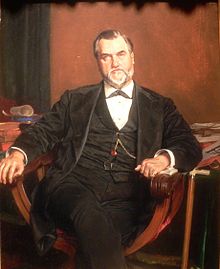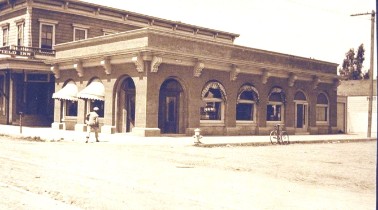The Meeting on the Corner: The Beginning of Mayfield's End
The California Avenue area has long
had an independent attitude. Sometimes called Palo Alto’s second downtown, California Avenue was once home to a stately row of the finest
houses in the city of Mayfield, which was incorporated into Palo
Alto in 1925. Originally, Mayfield was the larger town --- that is until it made a fatal mistake --- at least fatal in terms of being its own
entity.
In 1886, Senator Leland Stanford met with local Mayfielders on the corner of California and El Camino Real (then known as Lincoln and Main) to inform the locals about his big plans for a university in their town. He wanted the entrance gates to the university to be situated on Stanford Avenue near Hanover Street. One catch though --- Stanford wanted the town to go “dry” --- no more alcohol. Mayfield, with its 13 saloons, voted no thanks. Rejected, Stanford turned his eyes north and convinced his friend, Timothy Hopkins of the Southern Pacific Railroad, to buy 700 acres of private property and sell lots. The collection of homes that grew up around the university (originally called University Park) eventually became Palo Alto. It was also the beginning of the end for old Mayfield.
Mayfield soon fell on hard times. Workers who had lived in Mayfield during the building of Stanford University eventually chose to live in Palo Alto --- free from liquor, home to a university and a better place to raise children. As the wet, poorer relation to Palo Alto, Mayfield began to acquire an unsavory reputation. As grocer Frank Backus said at a Board of Trustees Meeting in 1904, “Mayfield people are tired of having the roughs from all around the country come here, get drunk and raise a row. We’re tired of renting our cottages for $5 and $6 a month…when a house can’t be had in Palo Alto for $20-$25.” Sound familiar? Those differences never did get much better --- landlords in South Palo Alto are still complaining about the difference in rents, although few would accept a $25 check these days.
In 1904, Mayfield voters, realizing their earlier mistake, finally did ban the saloons. And after originally ignoring the ban, 10 days in jail finally convinced saloon owners to throw in the towel. But Mayfield continued to be overshadowed in competition with their northerly neighbor. In 1905, Mayfield accused Palo Alto of “unsisterly conduct,” claiming Palo Alto had blocked the building of a road from Mayfield to Stanford’s main quad.
Finally, Mayfield decided that if you can’t beat ‘em, join ‘em. Plagued by money problems, bad roads and little leadership, a group of residents began an effort in 1918 for Mayfield to be annexed by Palo Alto. A first attempt at annexation was voted down in 1924, but a second passed, 357 to 288, less than a year later. Palo Altans agreed to the annexation, and the two communities officially consolidated on July 6, 1925. []
In 1886, Senator Leland Stanford met with local Mayfielders on the corner of California and El Camino Real (then known as Lincoln and Main) to inform the locals about his big plans for a university in their town. He wanted the entrance gates to the university to be situated on Stanford Avenue near Hanover Street. One catch though --- Stanford wanted the town to go “dry” --- no more alcohol. Mayfield, with its 13 saloons, voted no thanks. Rejected, Stanford turned his eyes north and convinced his friend, Timothy Hopkins of the Southern Pacific Railroad, to buy 700 acres of private property and sell lots. The collection of homes that grew up around the university (originally called University Park) eventually became Palo Alto. It was also the beginning of the end for old Mayfield.
Mayfield soon fell on hard times. Workers who had lived in Mayfield during the building of Stanford University eventually chose to live in Palo Alto --- free from liquor, home to a university and a better place to raise children. As the wet, poorer relation to Palo Alto, Mayfield began to acquire an unsavory reputation. As grocer Frank Backus said at a Board of Trustees Meeting in 1904, “Mayfield people are tired of having the roughs from all around the country come here, get drunk and raise a row. We’re tired of renting our cottages for $5 and $6 a month…when a house can’t be had in Palo Alto for $20-$25.” Sound familiar? Those differences never did get much better --- landlords in South Palo Alto are still complaining about the difference in rents, although few would accept a $25 check these days.
In 1904, Mayfield voters, realizing their earlier mistake, finally did ban the saloons. And after originally ignoring the ban, 10 days in jail finally convinced saloon owners to throw in the towel. But Mayfield continued to be overshadowed in competition with their northerly neighbor. In 1905, Mayfield accused Palo Alto of “unsisterly conduct,” claiming Palo Alto had blocked the building of a road from Mayfield to Stanford’s main quad.
Finally, Mayfield decided that if you can’t beat ‘em, join ‘em. Plagued by money problems, bad roads and little leadership, a group of residents began an effort in 1918 for Mayfield to be annexed by Palo Alto. A first attempt at annexation was voted down in 1924, but a second passed, 357 to 288, less than a year later. Palo Altans agreed to the annexation, and the two communities officially consolidated on July 6, 1925. []
Our Reader's Memories:
Be the First!
Send Us Your Memory!

Senator Leland Stanford posing. (PAHA)

Mayfield bank, circa 1915, on the corner where Leland Stanford met Mayfield residents. (PAHA)

Leland Stanford's home near Mayfield in 1888. (PAHA)